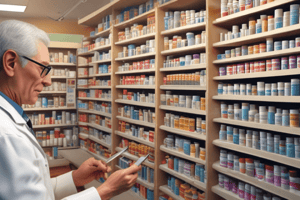Podcast
Questions and Answers
What is the primary goal of Therapeutic Drug Monitoring (TDM)?
What is the primary goal of Therapeutic Drug Monitoring (TDM)?
- To determine the cost-effectiveness of medications
- To measure patient blood volume
- To ensure drug concentrations remain within a therapeutic range (correct)
- To evaluate the patient's disease progression
Which of the following factors does NOT influence drug levels in TDM?
Which of the following factors does NOT influence drug levels in TDM?
- Presence of other medications
- Quality of the pharmaceutical company (correct)
- Timing of blood sample collection
- Genetic variability of the patient
What does the term 'therapeutic range' refer to in TDM?
What does the term 'therapeutic range' refer to in TDM?
- The maximum dose allowable for any medication
- The total amount of drug allowed in a single dose
- The concentration range where a drug is effective without causing adverse effects (correct)
- The range of drug interactions that can occur with various medications
When is it typically recommended to collect blood samples for TDM?
When is it typically recommended to collect blood samples for TDM?
Which of the following drugs is known for having a narrow therapeutic range necessitating careful monitoring?
Which of the following drugs is known for having a narrow therapeutic range necessitating careful monitoring?
Flashcards are hidden until you start studying
Study Notes
Therapeutic Drug Monitoring (TDM)
-
Definition:
- TDM is the clinical practice of measuring specific drug levels in a patient's bloodstream to optimize therapeutic efficacy and minimize toxicity.
-
Purpose:
- Ensure drug concentrations remain within the therapeutic range.
- Adjust dosages based on individual patient responses and factors such as age, weight, and organ function.
- Monitor adherence to prescribed therapy.
-
Key Components:
-
Drug Selection:
- Commonly monitored drugs include anticonvulsants, immunosuppressants, antidepressants, and antibiotics.
-
Therapeutic Range:
- The concentration range where a drug is effective without causing adverse effects. Below this range may lead to ineffective therapy, while above could cause toxicity.
-
Sampling Timing:
- Timing of blood samples is crucial, often taken at steady state or at specific intervals post-dose (e.g., peak and trough levels).
-
Interpreting Results:
- Requires understanding of pharmacokinetics (absorption, distribution, metabolism, excretion) and patient-specific factors.
-
-
Factors Influencing Drug Levels:
- Patient variables (genetics, age, weight, organ function).
- Drug interactions with other medications.
- Change in disease states (e.g., liver or kidney disease).
-
Common Drugs Monitored:
- Digoxin: Used for heart failure; needs careful monitoring due to narrow therapeutic range.
- Lithium: Common in bipolar disorder; requires regular checks to avoid toxicity.
- Warfarin: Anticoagulant; INR monitoring is a form of TDM.
- Antiepileptics: Such as phenytoin and valproate; important for seizure control.
-
Process of TDM:
- Identify the need for TDM based on drug characteristics and patient status.
- Collect blood samples at appropriate times.
- Analyze blood samples using techniques like immunoassays or mass spectrometry.
- Adjust therapy based on results and clinical judgment.
-
Challenges:
- Variability in drug absorption and metabolism among patients.
- Inconsistent laboratory results.
- Understanding the clinical relevance of results requires experience.
-
Conclusion:
- TDM is a critical tool in personalized medicine, enhancing treatment efficacy and safety through informed dosage adjustments and continuous monitoring.
Therapeutic Drug Monitoring (TDM)
- TDM aims to optimize drug effectiveness and minimize toxicity by measuring drug levels in the bloodstream.
- TDM ensures drug concentrations fall within the therapeutic range.
- Adjustment of dosages is based on patient responses, including age, weight, and organ function.
- TDM monitors adherence to prescribed medications.
- Key components of TDM:
- Drug Selection: Commonly monitored drugs include anticonvulsants, immunosuppressants, antidepressants, and antibiotics.
- Therapeutic Range: Defines the effective drug concentration range without causing adverse effects. Levels below this range lead to ineffective treatment, while levels above may induce toxicity.
- Sampling Timing: Timing of blood samples is crucial, often taken at steady state or at specific intervals post-dose (e.g., peak and trough levels).
- Interpreting Results: Requires understanding of pharmacokinetics (absorption, distribution, metabolism, excretion) and patient-specific factors.
- Patient variables, drug interactions, and changes in disease states influence drug levels.
Commonly Monitored Drugs
- Digitalis (Digoxin): Used for heart failure; requires careful monitoring due to a narrow therapeutic range.
- Lithium: Commonly used in bipolar disorder; regular checks are necessary to prevent toxicity.
- Warfarin: Anticoagulant; INR monitoring is a form of TDM.
- Antiepileptics: Such as phenytoin and valproate; vital for seizure control.
TDM Process
- The need for TDM is determined based on drug characteristics and patient status.
- Blood samples are collected at appropriate times.
- Analyzed using immunoassays or mass spectrometry.
- Therapy adjustments are based on results and clinical judgment.
Challenges
- Variability in drug absorption and metabolism among patients.
- Inconsistent laboratory results.
- Interpretation of results requires experience to ensure clinical relevance.
Conclusion
- TDM is a crucial component of personalized medicine, enhancing treatment efficacy and safety through informed dosage adjustments and ongoing monitoring.
Studying That Suits You
Use AI to generate personalized quizzes and flashcards to suit your learning preferences.




